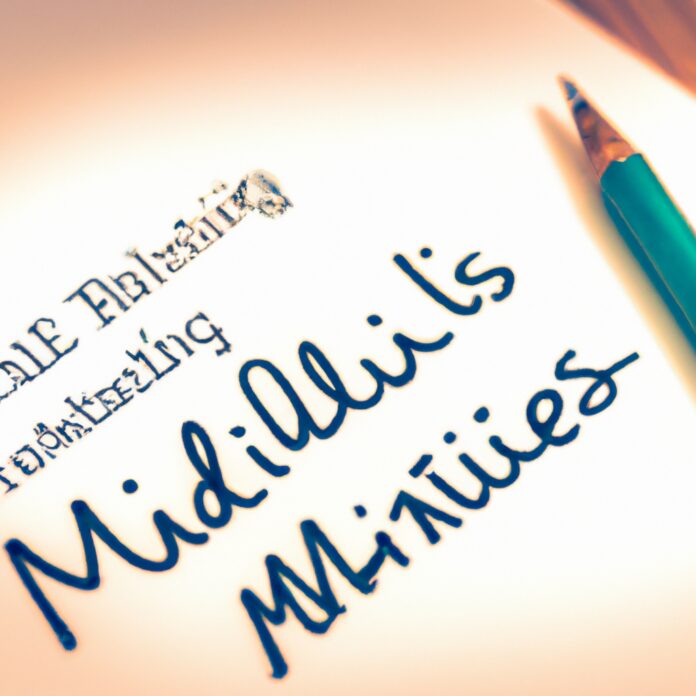Peace of mind is a state desired by many, yet achieved by few. The reward of a relaxed and stress-free mindset is becoming increasingly accessible to even the busiest of individuals, simply through meditation and mindfulness practices. This article explores the valuable tools that meditation and mindfulness offer and the profound level of inner peace one can experience as a result.
1. Unveiling the Journey Within: A Path to Inner Peace through Meditation and Mindfulness
The practice of meditation can help us access our innermost sense of peace and understanding. By taking time away from the distractions of everyday life, we can tap into our innermost wisdom and attain a greater sense of balance. When gently focused on our own inner experience, we can discover newfound clarity and allow a sense of calm into our lives.
The Benefits of Meditation and Mindfulness
The practice of meditation and mindfulness offers numerous physical and emotional benefits. Some of these include:
- A greater sense of focus and concentration
- Reduced levels of stress and anxiety
- A deeper understanding of our own needs and wants
- Heightened creativity and clarity of thought
- An increased ability to handle difficult emotions
- Increased feelings of compassion and acceptance for ourselves and others
These benefits are just a few of the wonderful rewards that come with a regular practice of meditation and mindfulness. The regular practice of meditation is not only an extremely helpful tool for reducing stress and anxiety, but it can also lead to more meaningful relationships with ourselves and with others.
Creating a Meditation or Mindfulness Practice
Meditation and mindfulness can be practiced in many forms. Some people prefer to sit in silence and focus on their breath, while others prefer to spend time with their thoughts or while engaging in a physical activity such as walking or yoga. Regardless of which approach we choose, the most important factor is to be consistent with our practice.
In order to create a successful practice, it’s important to establish a regular practice that feels manageable. This means experimenting with different techniques and durations until we find an approach that works for us. Once we’ve found an approach that works for us, it’s important to keep working on developing our practice, by gradually increasing the duration and intensity of our practice over time.
Conclusion
Meditation and mindfulness are powerful tools to help us access our own inner peace and understanding. We can achieve these benefits by taking time away from the distractions of everyday life and deliberately exploring our own inner experience. With a regular and consistent practice, we can gain various physical and emotional benefits and deepen our understanding of ourselves and our relationships with others.
2. Exploring the Art of Stillness: Nurturing Tranquility in the Chaos of Modern Life
From the hustle and bustle of busy streets to our technology-driven lives, we can often find ourselves overwhelmed and stressed in our modern world. Finding tranquility in the chaos can be difficult, yet so rewarding. Exploring the art of stillness is a great way to nurture peace and quiet in this noisy age.
1. Start with small steps
We can easily be tempted to want to reach zen-like states of ultimate tranquility overnight, but the path to stillness is more of a journey than a destination. Start by carving out just five minutes a day for stillness practice. This could be taken simply by taking a few deep breaths, sitting in silence, counting your exhalations, or even doing some light meditation or mindfulness activities. Even the smallest steps can make a big difference.
2. Connect to nature
Incorporate nature into your stillness practice. Going for a leisurely walk or spending time around trees and plants can help you reconnect with the world. Step away from the screens and into the outdoors – it’s an opportunity to observe and appreciate the beauty of the world around you.
3. Give yourself permission
Sometimes our own minds stand in the way of our path to tranquillity. We can often tell ourselves that we don’t have the time or the resources to be mindful and practice stillness! Give yourself permission to take those steps to stillness. Remind yourself that it is ok to prioritize your mental and emotional wellbeing.
4. Practice being intentional
Be intentional with your stillness practice. Spend your time focusing on making yourself full, rather than empty – which is what we often resort to when we are stressed. Intentional stillness is about listening to yourself and taking the time to be mindful of the situation you are in.
5. Find gratitude
Gratitude is a powerful way to bring more peace and quiet into your life. Before you start or end your stillness practice or meditation, take the time to notice three things you are grateful for. Reframing your perspective from gratitude can bring a sense of relief and contentment.
Each person’s path to serenity is unique. Go ahead and explore the art of stillness and nurtures tranquility in the chaos of modern life.
3. Taming the Mind, Igniting Serenity: How Meditation and Mindfulness Foster Inner Peace
Stress and anxiety plague many of us in this hurried and fast-paced world. It can be hard to keep up, and the never ending to-do list of tasks is often overshadowed by life’s challenging moments. Fortunately, mediation and mindfulness can provide a refuge from the whirlwind of life.
Mindfulness is a practice that requires complete and undivided attention to the present. It is grounded in the decision to be consciously aware and to observe yourself and your surroundings. By doing this, you can become more mindful of your thoughts and better gauge your reactions to events. As a result, you can create meaningful and authentic responses instead of knee-jerk reactions.
Meditation, on the other hand, is a form of self-care that requires trained awareness and concentration. It invites us to become aware of our thoughts and acknowledge them without judgement. This is because meditation provides us with the opportunity to observe our thoughts and recognize how fleeting they are. Through this process, we come to understand that no thought, good or bad, lasts infinitely.
The mindfulness and meditation practices each come with their own set of benefits:
- Calms the body and the mind: Sitting and focusing on the present can release any physical tension as well as help ease both mental and emotional stress.
- Lets emotions flow: Allowing ourselves to feel both positive and negative emotions has many rewards, including a more in-depth understanding of ourselves and our relationships.
- Provides a sense of gratitude: By focusing our attention on the moment and everything around us, we become more cognizant and appreciative of existing in the present.
- Brings clarity: Allowing ourselves to become aware of what’s happening internally and externally can lead to an understanding of why certain situations might affect us.
Meditation and mindfulness invite us to step away from the chaos of life and to focus on gratitude and acceptance. They allow us to be with our thoughts and acknowledge intense emotions without judgement. By investing in these practices, we can ultimately foster a sense of peace, calmness, and joy.
4. The Alchemy of Presence: Harnessing the Power of Meditation and Mindfulness to Cultivate Inner Harmony
For many, meditative practices are closely associated with spirituality and religious traditions; however, the art of being present in the moment has so much more to offer. Whether it’s your first time setting up a meditation cushion or you’ve been practicing for decades, being mindful of the present moment can help create and nurture inner peace and equilibrium. Through meditation and mindfulness practices, we can learn to bring forth the powerful alchemy of presence into our daily lives.
- Become aware of the mind-body connection. Awareness of this connection helps us notice how our thoughts, feelings, and emotions can manifest physical sensations in the body.
- Turn inward to identify the moments of self-doubt. When you find moments of uncertainty, take an intentional pause, observe your thoughts, and practice reprogramming with more empowering beliefs.
In mindfulness meditation, we learn to observe our thoughts and emotions non-judgmentally and compassionately. This allows us to be present in the moment and open to the metaphysical possibilities that exist in our lives. Through the cultivation of inner clarity, we gain a greater understanding of who we truly are. This inner wisdom gives us the power to take charge of our circumstances and forge a path that leads to our purpose and fulfillment.
Mindfulness meditation brings us to the present moment, allowing us to be “in the now” and accessing our creative solutions. This practice gives us the capacity to channel the energies of resilience and mental strength to overcome obstacles. Our awareness of the internal obstacles that come with external challenges help us to identify the ways to move forward in a more peaceful, harmonic way.
Through meditation and mindfulness, we can access the power of presence to transform our lives and relationships. When cultivated regularly, presence brings the sense of inner alignment that is essential to living our fullest, most authentic selves.
At the end of your journey, the goal of mindfulness and meditation is to achieve an inner peace. When you attain this state, you will be fully content with yourself and your life, without any distractions or anxieties. You will finally be able to enjoy each moment, while allowing yourself to be truly present and live life with intention. So, don’t forget to take pause every day and nourish your inner peace – for it is the foundation of a happier and more fulfilling life.




